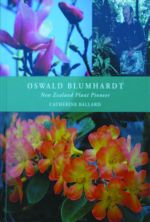 BOOK
REVIEWS BOOK
REVIEWS
Oswald
Blumhardt
New Zealand Plant Pioneer
Catherine Ballard
David Ling
Distributed by David Bateman
NZ$40.00
Reviewed by Murray Dawson
Too often our horticultural
experts, plant breeders, and skilled nurserymen and women fade into
anonymity. Not so for the late Oswald (Os) Blumhardt thanks to the
well researched biography written by Catherine Ballard.
As recounted by Ballard,
Os Blumhardt (1931-2004) was of German descent but born in the North
Island of New Zealand, where he lived for most of his life. He was
raised on a dairy farm, and in 1949 left home to undertake a Royal
New Zealand Institute of Horticulture apprenticeship at the Duncan
and Davies nursery in New Plymouth.
The apprenticeship provided
Os with the training to set up his own nursery on his parent's property.
His nursery, located near Whangarei in Northland, was called Koromiko
Nursery, and according to Ballard was named after the hebe plants
that were first raised there.
As a skilled plantsman,
Os was an active member of many societies, including the Royal New
Zealand Institute of Horticulture, the New Zealand and International
Camellia Societies, the Magnolia Society, the Lily Society, and
the Orchid Society.
He was an avid plant
collector and breeder, and these activities form the basis of subsequent
chapters. Assembling the large and unique collection and the careful
breeding work that followed was Os's passion, and no secret is made
that he was better at this than running a solely commercial operation.
However, in the end, it is the world-class cultivars that he produced
that make the real contribution to horticulture.
Following on from the
introductory sections, Chapters 3-6 are essentially travelogues,
and Ballard recounts Os's collecting trips to Borneo, Thailand,
Fiji, Papua New Guinea, and Vietnam. The main groups collected by
Os appear to be magnolias, camellias, rhododendrons, and orchids,
but many other plants were collected as well. Several species were
brought into cultivation for the first time, especially for New
Zealand, and it is interesting that comments are made on the increased
difficulties in latter trips to import material under the new biosecurity
regulations. As a consequence, several consignments were delayed
or destroyed at the border.
The subsequent chapters
logically shift focus to Os's hybridisation work; Magnolia
(Chapter 7), Camellia (Chapter 8), Rhododendron (Chapter
9), and other plants (Chapter 10).
Magnolia Hybrid
'Star Wars' (M. campbellii x M. liliiflora) is an
outstanding cultivar arising from his breeding programme, and is
regarded as one of the best grown around the world. In 2003, Os
received the Todd Gresham Award from the Magnolia Society International
for his work on this genus.
Camellia 'Night
Rider' is Os's best known camellia hybrid, and is still increasing
in popularity worldwide for its dramatic foliage and dark red flowers.
The majority of Os's
successful breeding of rhododendrons was in the Vireya group (the
so-called "tropical" rhododendrons). As related by Ballard, Vireya
rhododendrons have a short history of plant breeding, and provided
an important opportunity for Os Blumhardt. He imported several species
and produced many fine hybrids, including Rhododendron 'Tropic
Glow', R. 'Saxon Glow', and R. 'Saxon Blush'.
This book is well illustrated
with black and white photos and a central section in colour. Ballard's
writing style is clear and she succeeds in making the subject matter
interesting. There are a few small typographical errors and inconsistencies,
especially misspellings for some of the plant names, but this is
a minor quibble.
Although this book will
never be as popular as, for example, yet another rose book, we do
need more accounts like this. Books like Ballard's provide an interesting,
historically important, and accurate record of our horticultural
pioneers. In addition to the cultivars that live on, so too does
the memory of the man who created them.
Also
see the Weekend Gardener review of this book
|